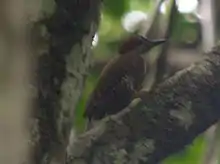| Pardipicus | |
|---|---|
 | |
| Brown-eared woodpecker (Pardipicus caroli) | |
| Scientific classification | |
| Domain: | Eukaryota |
| Kingdom: | Animalia |
| Phylum: | Chordata |
| Class: | Aves |
| Order: | Piciformes |
| Family: | Picidae |
| Tribe: | Picini |
| Genus: | Pardipicus Bonaparte, 1854 |
| Species | |
|
see text | |
Pardipicus is a genus of bird in the family Picidae, or woodpeckers, that are native to the African tropical rainforest. Most species are native to woodland and savanna rather than deep forest, and multiple species exhibit either arboreal or terrestrial foraging strategies.[1]
| Image | Common Name | Scientific name | Distribution |
|---|---|---|---|
| Buff-spotted woodpecker | Pardipicus nivosus | Angola, Cameroon, Central African Republic, Republic of the Congo, Democratic Republic of the Congo, Ivory Coast, Equatorial Guinea, Gabon, Gambia, Ghana, Guinea, Guinea-Bissau, Kenya, Liberia, Mali, Mauritania, Nigeria, Rwanda, Senegal, Sierra Leone, South Sudan, Tanzania, Togo, and Uganda. | |
 | Brown-eared woodpecker | Pardipicus caroli | Angola, Cameroon, Central African Republic, Republic of the Congo, Democratic Republic of the Congo, Ivory Coast, Equatorial Guinea, Gabon, Ghana, Guinea, Guinea-Bissau, Kenya, Liberia, Nigeria, Sierra Leone, South Sudan, Tanzania, Uganda, and Zambia. |
Description
They are small to medium-sized woodpeckers.[2] The sexes are fairly similar, but males of most species have the crown and nape bright red, while in females this is restricted to the nape. Colour of the malar plumage is also useful in sexing.
Their plumage pattern is fairly uniform, and some species are only distinguishable by careful observation.[2] The mantle, back and wings are olive-greenish, and usually spotted or barred in buffy to golden yellow. The shafts of the remiges and rectrices are yellow to golden yellow.[2] The underpart plumage is spotted black to a lesser or greater degree.
Some species include drumming on dead wood as a means of non-vocal signaling.
Foraging
Their rectrices are only partially stiffened (for arboreal support), and they readily take to terrestrial foraging. Ants and termites form important components of their diet. These are lapped up with a flexible and sticky tongue.[2]
References
- ↑ Fuchs, Jérôme; Pons, Jean-Marc; Bowie, Rauri C.K. (March 2017). "Biogeography and diversification dynamics of the African woodpeckers". Molecular Phylogenetics and Evolution. 108: 88–100. doi:10.1016/j.ympev.2017.01.007. PMID 28089840.
- 1 2 3 4 Gorman, Gerard (2014). Woodpeckers of the World: The Complete Guide (Helm Photographic Guides). London: Bloomsbury. p. 165. ISBN 978-1408147153.